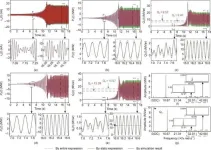(Press-News.org) AMES, Iowa – The amount of nitrogen fertilizer needed to maximize the profitability of corn production in the Midwest has been increasing by about 1.2% per year for the past three decades, according to new Iowa State University research.
The study, published last month in Nature Communications, analyzed data from prior long- and short-term studies by Iowa State and the University of Illinois to calculate the Corn Belt’s steadily rising optimum nitrogen rates, which researchers had thought were static over time despite year-to-year fluctuations. Authors of the study primarily attributed the increase in optimum nitrogen rates from 1991 to 2021 to increased loss during wetter springs and the nutrient demands of higher yields, which also rose about 1.2% per year over the same time span.
“As much of a surprise as it was to us, it really wasn’t a surprise when you sat down and thought about it,” said study co-author Michael Castellano, agronomy professor and the William T. Frankenberger Professor in Soil Science. “It’s like a bank account. If you pull money out, you need to deposit more money to keep the account going.”
The analysis tracks with surveys of Iowa farmers, whose self-reported rates of applying nitrogen fertilizer on corn also have increased in recent decades.
“Seeing this study come out, I’m sure some of them will say, ‘I knew it!’,” said study co-author Sotirios Archontoulis, Pioneer Hi-Bred Agronomy Professor.
Efficiency improving
Data-based confirmation of corn’s climbing nitrogen needs reiterates the importance of continuously improving the efficiency of fertilizer use, which is essential to limit the impact on water quality and greenhouse gas emissions. Knowing the science is more in synch with farmers’ experiences may help build confidence in expert recommendations for effectively applying nitrogen fertilizer, said professor of agricultural and biosystems engineering and Brent and Cindy Hart Professor Matthew Helmers, director of the Iowa Nutrient Research Center, the study’s primary funder.
“Farmers hear information from lots of different sources. There’s some uncertainty there,” said Helmers, also a co-author of the study. “But the more they can fine tune their nitrogen management, the greater return they’ll see on their investment in the field and the more we will reduce environmental losses.”
While there’s still room to grow, farmers have become more efficient in applying nitrogen fertilizer. Using 0.7 pounds of nitrogen or less per bushel of corn is a common goal in recent years for Iowa farmers, but Iowa State’s recommendation was 1 pound per bushel 20 years ago and 1.2 pounds per bushel 30 years ago, Castellano said. Rising optimum nitrogen rates over the last 30 years would have been even higher if improved efficiency hadn’t slowed the increase.
Crop rotation, improved drainage and spring fertilizer application are among the highest-impact practices for increasing nitrogen use efficiency, according to an ISU Extension and Outreach tipsheet released last year by many of the same researchers who contributed to the new study.
Applying the right amount of nitrogen is also crucial, and farmers have more resources than ever for setting rates specifically tailored to individual fields. The Iowa Nitrogen Initiative conducts trials on private farms across the state, using the data and cropping system modeling to offer Iowa corn farmers more precise suggested nitrogen rates. The public-private partnership – led by Castellano and Archontoulis and supported by the Iowa Department of Agriculture and Land Stewardship and numerous commodity groups – earlier this month released the initial version of its digital decision support tool. N-FACT (Nitrogen Fertilizer Application Consultation Tool) recommends custom rates by location, weather, soil nitrogen, planting date, cropping system and market prices.
“Farmers knew optimum rates were increasing before we did, and now through our partnership with farmers, the research will closer match the actual realities of on-farm production,” Castellano said.
Trend likely to continue
Efficiency has a bigger impact on the environmental sustainability of nitrogen fertilizer than the rate at which it’s applied. That’s good news because optimum rates are likely to continue inching higher, said Mitchell Baum, a postdoctoral research associate in the agronomy department and first author of the study.
“As long as yields are going to increase, unless there are massive increases in efficiency, we don’t see any signs of this slowing down,” Baum said.
The analysis outlined in the study focused on three different types of optimum nitrogen rates: economic, agronomic and environmental. The economic optimum is based on maximizing farmer profits, the agronomic optimum is the point at which additional nitrogen has no effect on yield and the environmental optimum incorporates the estimated financial cost of nitrous oxide emissions and nitrate leaching into groundwater.
The economic optimum is always lower than the agronomic optimum and higher than the environmental optimum, but the gaps between the rates are changing. The difference between the max-yield agronomic optimum and the max-profit economic optimum shrank by 79% over the 30 years studied, while the difference between the economic and environmental rates grew by 34%.
Reducing nitrogen fertilization rates to the environmental optimum would cause a drop in yield of about 6% while only slightly reducing nitrogen loss, an unfavorable trade-off, Archontoulis said.
“If you want to cut nitrogen fertilizer rates below the required optimum and also maintain yields, well, we can’t have everything. If you reduce the nitrogen, you reduce yield,” he said.
END
Ideal nitrogen fertilizer rates in Corn Belt have been climbing for decades, Iowa State study shows
2025-03-03
ELSE PRESS RELEASES FROM THIS DATE:
Survey suggests people with disabilities may feel disrespected by health care providers
2025-03-03
Embargoed for release until 5:00 p.m. ET on Monday 3 March 2025
Follow @Annalsofim on X, Facebook, Instagram, threads, and LinkedIn
Below please find summaries of new articles that will be published in the next issue of Annals of Internal Medicine. The summaries are not intended to substitute for the full articles as a source of information. This information is under strict embargo and by taking it into possession, media representatives are committing to the terms of the embargo not only on their own behalf, but also on behalf of the organization they ...
U-Michigan, UC Riverside launch alliance to promote hydrogen-fueled internal combustion engines
2025-03-03
March 3, 2025
Contact: Jim Lynch, 313-727-5045, lynchja@umich.edu, Katherine McAlpine, 734-647-7087, kmca@umich.edu
Images
ANN ARBOR—Hydrogen has the potential to power internal combustion engines, including on-road and off-road vehicles and equipment, and large marine engines. Despite its promise to reduce climate change emissions such as carbon dioxide and harmful pollutants, hydrogen has largely remained underutilized in the United States.
Officials at the University of Michigan and University of California, Riverside, along with several industry partners, are working to change that with the launch of the Hydrogen Engine Alliance of North America, or H2EA-NA. ...
New insights into network power response: Unveiling multi-timescale characteristics
2025-03-03
A recent study published in Engineering delves into the power response characteristics of networks when excited by voltage with time-varying amplitude and frequency (TVAF). This research, led by Yingbiao Li and colleagues from various institutions, addresses a crucial gap in understanding the behavior of power systems in the era of increasing power electronic equipment integration.
With the growing prominence of renewable energy power generation and grid-connected electronic equipment, the traditional assumptions in power system analysis ...
Simple algorithm helps improve treatment, reduce disparities in MS
2025-03-03
EMBARGOED FOR RELEASE UNTIL 4 P.M. ET, MONDAY, MARCH 3, 2025
Media Contacts:
Renee Tessman, rtessman@aan.com, (612) 928-6137
Natalie Conrad, nconrad@aan.com, (612) 928-6164
Simple algorithm helps improve treatment, reduce disparities in MS
MINNEAPOLIS – A simple treatment algorithm may help reduce treatment disparities for Hispanic and Black people with multiple sclerosis (MS), according to a preliminary study released today, March 3, 2025, that will be presented at the American Academy of Neurology’s 77th Annual Meeting taking place April 5–9, 2025, in San Diego and online.
“Studies show Hispanic and ...
Despite high employment rates, Black immigrants in the United States more likely to be uninsured, USC study shows
2025-03-03
Black immigrant adults in the United States are more likely to be uninsured than their U.S.-born and non-Black immigrant counterparts, despite having the highest employment rates among the groups studied, according to new research from the Equity Research Institute (ERI) at the USC Dornsife College of Letters, Arts and Sciences.
Published in Health Affairs, the study highlights critical health care access gaps for this rapidly growing segment of the U.S. population, suggesting possible links to wage penalties and systemic ...
Research supports move toward better tailoring stroke rehabilitation
2025-03-03
WASHINGTON – A new Georgetown University Medical Center study in collaboration with MedStar Health and the National Institutes of Health exploring a new brain imaging technique is bringing stroke experts a step closer to better tailoring rehabilitation.
Neurologists often use MRI images of the brain’s white matter to glean information about a person’s ability to recover, but a new imaging technique added to MRI allows clinicians to better see the condition of white matter tracts leading to the limbs, an observation usually only seen after death during an autopsy.
“A white matter tract called the corticospinal ...
Imagining future events changes brain to improve healthy decision-making, new study indicates
2025-03-03
Learning to think more about specific events in the future appears to reduce impulsivity, improve decision-making, and shows potential as a therapy for alcohol use disorder, a new Virginia Tech study found.
The study, which involved 24 participants whose brains were scanned during both resting-state and task-based fMRI, showed brain connections were altered by future thinking.
The research, published recently in the journal Brain Connectivity, was among the last led by the late Warren Bickel, professor and director of the Addiction Recovery Research Center at the Fralin Biomedical Research Institute ...
Turning plastic waste into valuable resources: A new photocatalytic approach
2025-03-03
A recent study published in Engineering presents an innovative strategy for converting plastic waste into useful products. The research, led by a team of scientists from the Korea Institute of Science and Technology (KIST) and other institutions, focuses on polystyrene (PS), a commonly used plastic that poses significant challenges for waste management.
Plastic pollution has become a pressing environmental issue due to the increasing production and improper disposal of plastic products. PS, in particular, is difficult to degrade naturally and often ends up in landfills or the environment, contributing to the spread of microplastics. Current methods for treating ...
Sea otters help kelp forests recover — but how fast depends on where they are
2025-03-03
When sea otters were reintroduced along the coastlines of islands in Southern California and British Columbia, researchers saw kelp forests return to areas that were destroyed by sea urchins. But how slow or fast they grew back depended on the location — and until now, scientists didn’t understand why.
New CU Boulder research found sea otters, an important keystone species, play a vital role in kelp forest recovery, but their level of influence depends on what other species they interact with in salty Pacific Ocean waters. The study, published ...
Study links intense energy bursts to ventilator-induced lung injury
2025-03-03
A new study from Tulane University suggests that repeated collapse and reopening of tiny alveoli—air sacs in the lungs essential for breathing—during mechanical ventilation may cause microscopic tissue damage, playing a key role in ventilator-related injuries that contribute to thousands of deaths annually.
Published in the Proceedings of the National Academy of Sciences (PNAS), the study sheds light on ventilator-induced lung injury, a complication that gained increased attention during the COVID-19 pandemic, which led to a surge in patients requiring ...




